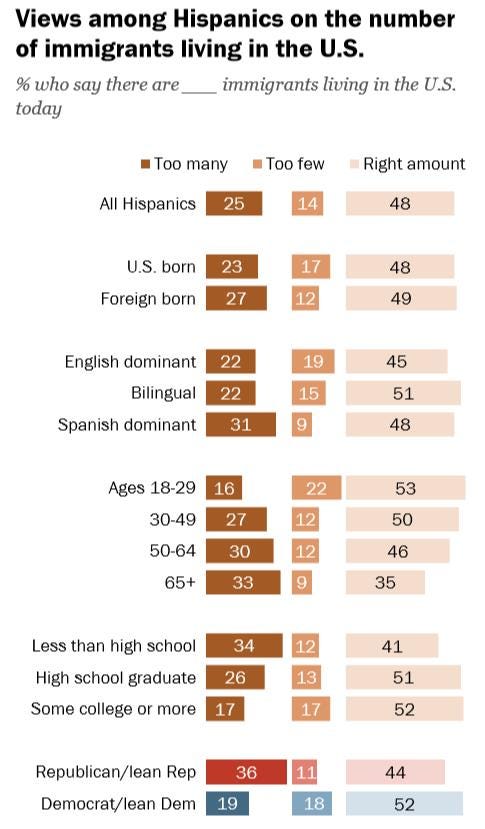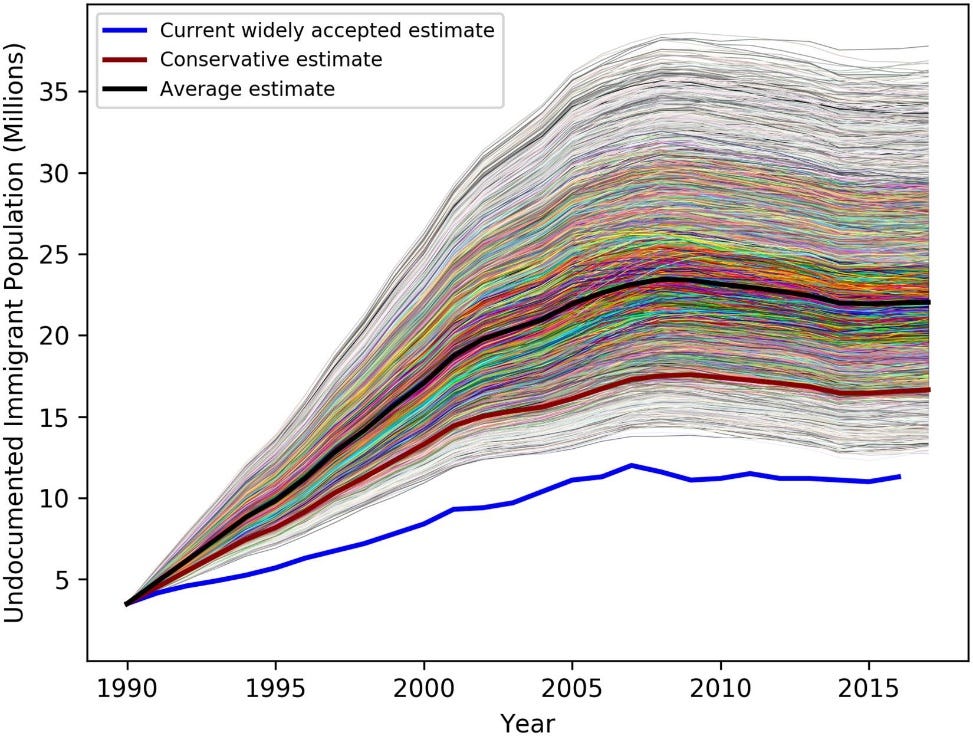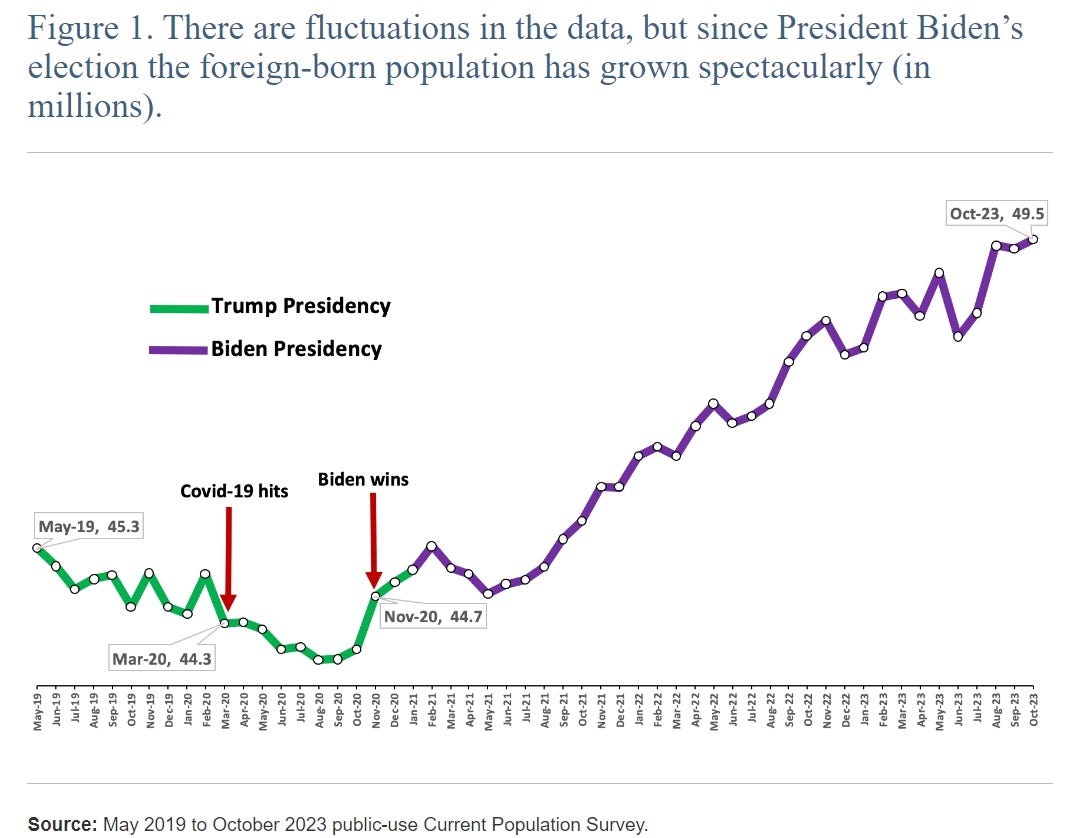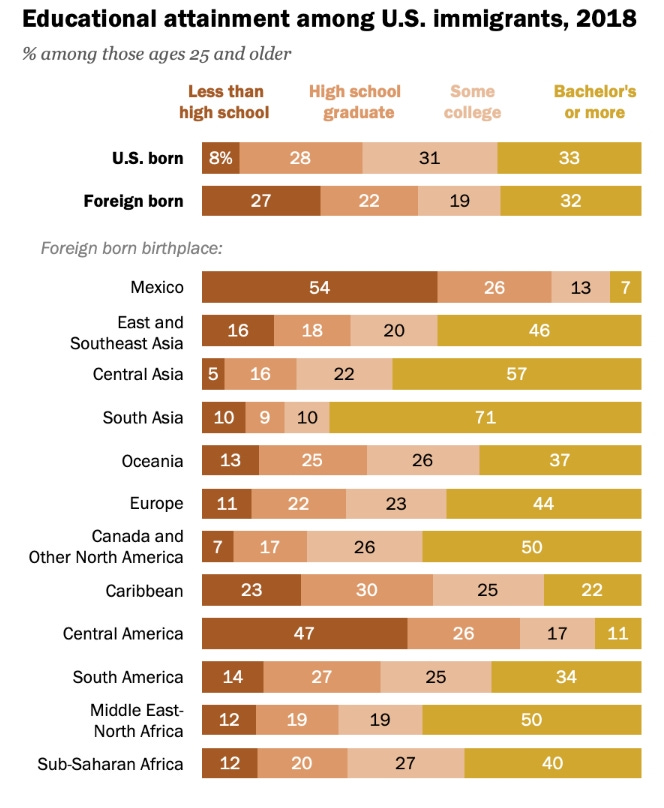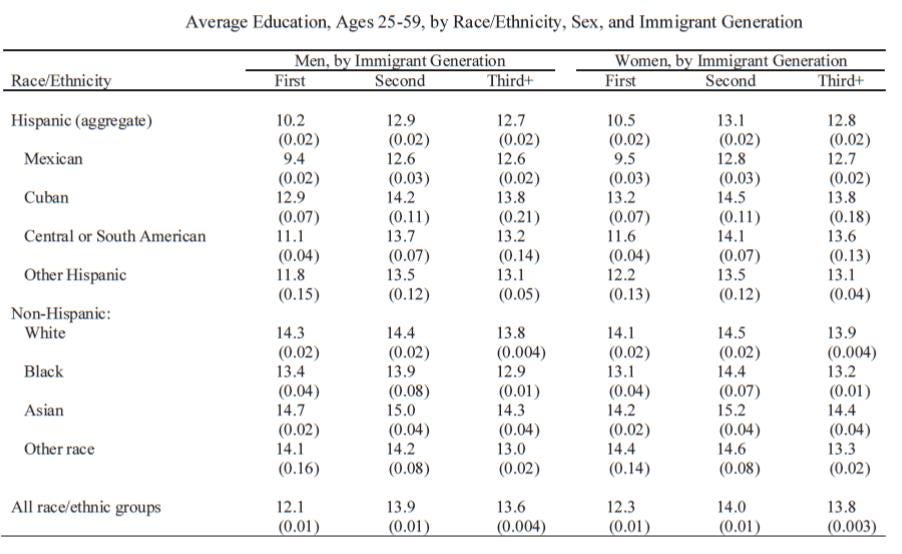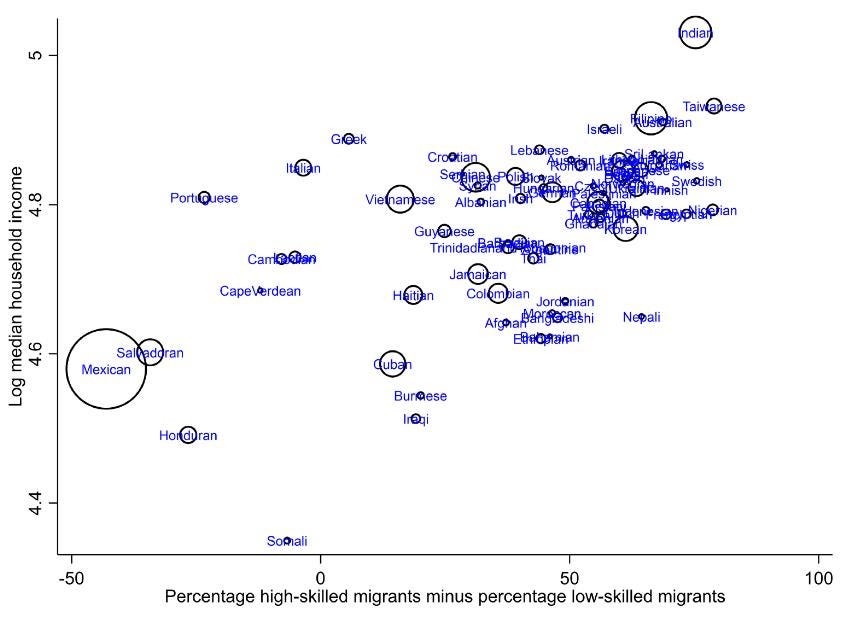Immigration – Part 1
Immigration and education.
As was explored in the previous essay, the impeachable offenses of Secretary of Homeland Security Mayorkas related to his purposeful violation of various border enforcement laws. In this essay series, we’ll explore some of the dire consequences of those violations.
As a matter of background, a Pew survey found that, back in 2018, when illegal immigration was significantly lower, 73 percent of U.S. Hispanics even then thought there were either “too many” or the “right amount of” immigrants in the U.S.
Even before the recent unprecedented surge in illegal entrants to the United States, researchers at Yale University had found that the number of illegal aliens in the U.S. was much greater than commonly reported, concluding that “We apply standard demographic principles of inflows and outflows to estimate the number of undocumented immigrants in the United States, using the best available data, including some that have only recently become available. Our analysis covers the years 1990 to 2016 … Our conservative estimate is 16.7 million for 2016, nearly fifty percent higher than the most prominent current estimate of 11.3 million, which is based on survey data and thus different sources and methods.”
Under the administration of President Donald Trump, the border became largely controlled. As Todd Bensman writes in his book Overrun: How Joe Biden Unleashed the Greatest Border Crisis in U.S. History:
Shortly after Donald Trump’s upset 2016 victory and January inauguration, official State of Texas business brought me to two ICE [Immigration and Customs Enforcement] immigration detention centers in South Texas. It was part of my routine then to help the feds interview apprehended aliens from Pakistan, Syria, Somalia, and Afghanistan to collect intelligence about potential Islamic terrorism. The South Texas Processing Center in Pearsall, Texas, some one hundred miles from the Mexican border, was always filled to the brink with detainees. But to my surprise, for the first time, it was as empty as a football stadium in baseball season. So was ICE’s larger, ever-packed-to-capacity Port Isabel center near Brownsville, Texas. “Where is everyone?” I asked the ICE intelligence officers, separately at both facilities. The same surprising answer went something like this: people throughout Latin America heard Trump campaign vows to crack down on illegal immigration and decided to stay home, the intelligence officers explained. Most of these people who did try were here, in their ICE detention cells, all the money in smuggling fees they’d spent to get over the border, gone with nothing to show for it. The ones back in home countries didn’t want to risk the money with Trump promising to deport them, so they stopped coming, they explained. It was the first time I’d heard such a thing, although it seemed so obvious. Before people gambled thousands of dollars in smuggling fees, they wanted reasonable assurance that the money would pay off with successful entries and long-term stays working and earning back many multiples of the investment. If they thought the odds were too low of that happening, they stayed home. That easy, uncomplicated calculus now had some evidence behind it. Huge, empty detention centers and short cafeteria lines in ICE detention facilities for me and the intelligence officers put a fine point on it. But more importantly, immigrants they were catching and interviewing attested to it, the intelligence officers told me, and some of it was even in the media … “Right now, nobody wants to go” to the United States, Honduran national Victoria Cordova told Reuters in March 2017 for a story about the impact of Trump’s border crackdown talk. “If in the future the situation looks better, well, I imagine then people will be more willing to travel.”
However, when Joe Biden became president, the number of illegal entrants surged to historic proportions. As Bensman writes:
Assuming … other variables remain unchanged, a reasonable projection is seven million total admittances from inauguration to January 2025 term completion … That is a megacity on the order of Los Angeles and Chicago combined, of mostly unskilled, uneducated, uninsured people speaking a Babylon of languages and in need of public welfare assistance and medical care for which many will never pay. Only time knows if the number reaches seven million by end-of-term … That constitutes transformative changes to the nation in terms of fiscal burden on those who already live here, on public education, health care, social welfare, and criminal justice systems … The 2.4 million who were admitted or slipped into America under Biden in his first eighteen months -- averaging about 139,000 per month -- compares to the 84,000 processed per month of Ellis Island’s 1907 grand peak, what History.com’s webpage reported as “a whopping” 1,004,756. Most years at Ellis saw an average of a couple hundred thousand in a year. That is typical of any single month of the Biden crisis … The number of aliens ordered deported by a judge but who instead got to stay more than tripled from about 76,000 in 2020 to 260,000 by May 2022, the highest since the government began keeping records on these, according to Syracuse University’s Transactional Records Access System.
As a result:
The Census Bureau’s Current Population Survey (CPS) shows that the total foreign-born or immigrant population (legal and illegal) was 49.5 million in October 2023 — a 4.5 million increase since President Biden took office and a new record high. At 15 percent, the foreign-born share of the U.S. population is also the highest ever recorded in American history. As the debate rages over the ongoing border crisis, this finding is important because administrative numbers such as border encounters or even legal immigrant arrivals do not measure the actual size of the immigrant population, which is what ultimately determines immigration’s impact on the country.
Among the findings:
· In October 2023, the CPS shows that 15 percent of the U.S. population is now foreign-born — higher than any U.S. government survey or census has ever recorded.
· The 49.5 million foreign-born residents (legal and illegal) in October 2023 is also a new record high.
· Since President Biden took office in January 2021, the foreign-born population has grown by 4.5 million — larger than the individual populations of 25 U.S. states.
· Based on our prior estimates of illegal immigrants, more than half (2.5 million) of the 4.5 million increase in the foreign-born population since January 2021 is likely due to illegal immigration. If adjusted for those missed by the survey, the increase would be larger.
· The 4.5 million increase overall and the 2.5 million increase in illegal immigrants are both net figures. The number of new arrivals was significantly higher, but was offset by outmigration and natural mortality among the foreign-born already here.
· The foreign-born population has grown on average by 137,000 a month since President Biden took office, compared to 42,000 a month during Trump’s presidency before Covid-19 hit, and 68,000 a month during President Obama’s two terms.
· The scale of immigration is so high that it appears to have made the new Census Bureau population projections, published on November 9 of this year, obsolete. The bureau projected that the foreign-born share was not supposed to hit 15 percent until 2033.
As Bensman writes in his book Overrun, this historic increase in illegal immigration included previously convicted aliens and aggravated felons:
Biden’s DHS sandbagged a traditional annual ICE deportations report that would have shown how many criminal aliens it deported. The reason became clear when ICE insiders leaked the data and when federal records requests showed what had befallen the country. Deportations of convicted criminal aliens and aggravated felons sharply plummeted. Under Biden, ICE arrested 48 percent fewer convicted criminals, deported 63 percent fewer criminals, and issued 46 percent fewer requests to other law enforcement agencies to detain criminals for them, according to a Washington Times report based on the leaked data.
As disturbing as that might be, far more common is that illegal entrants have had poor educations and bring limited skills. Reviewing data over the last couple of decades, fifty-six percent of immigrants from Mexico and Central America had less than a high school diploma or its equivalent as of 2009.
Fifty-four percent of immigrants from Mexico had less than a high school diploma or its equivalent in 2018.
As of a decade ago, educational attainment remained low into the third Mexican immigrant generation, with little or no increase in educational attainment between the second and third generations.
And as other researchers have pointed out:
The education and earnings patterns presented thus far suggest that progress stalls after the second generation for Hispanics overall and for Mexicans in particular … [S]everal factors … could slow the pace of intergenerational integration by Hispanics today as compared to Europeans in the past. These factors include the vast scale of current immigration flows from Mexico and other Spanish-speaking countries, the substantial (though lessening) geographic concentration of these flows within the United States, and the fact that such flows have remained sizable over a much longer period of time than did the influx from any particular European country. In addition, the close proximity of Mexico to the United States facilitates return and repeat migration. These unique features of Hispanic immigration might foster the growth of ethnic enclaves in the United States where immigrants and their descendants could, if they so choose, live and work without being forced to learn English or to Americanize in other important ways … Moreover, today’s economy provides fewer opportunities for unskilled workers to advance than did the economy that greeted earlier European immigrants. Around 1900, high school completion was uncommon for native-born Americans, so while many European immigrants arrived with relatively meager educations, their skill disadvantage was smaller than that faced today by Hispanic immigrants who typically lack the additional years of high school and college that have become the norm for U.S. natives. Furthermore, recent decades have witnessed a large rise in earnings inequality among American workers, driven by substantial increases in the labor market payoffs to education and other indicators of skill. As a result, the human capital deficit possessed by most Hispanic immigrants has become even more of a liability in our modern economy that places a higher premium on knowledge and cognitive ability.
One researcher found that “immigrant groups that are more skill-selected tend to have higher average incomes. The five most skill-selected groups are: Taiwanese, Nigerians, Swedes, Indians and Swiss. The five least skill-selected groups are: Mexicans, Salvadorans, Hondurans, Portuguese and Cape Verdeans. For example, 82% of Nigerians are high-skilled, while only 4% are low-skilled. By contrast, only 14% of Mexicans are high-skilled, while 57% are low-skilled.”
A Harvard-Harris survey found that American prefer a system of prioritizing legal immigrants based on their ability to contribute, based on their education and skills, over one based on immigrants having relatives in the United States, 79 to 21 percent. That includes a majority of white (79 percent), Hispanic (72 percent), and black (85 percent) citizens, as well as majorities of Democrats (72 percent), liberals (65 percent), and Clinton voters (72 percent).
Of course, America should remain a place of opportunity and welcome immigrants who — while they might have limited educations — also have the drive to work and contribute net benefits to society as a whole. But there is a correlation between limited education and disproportionate reliance on government benefits programs. In the next essay in this series on immigration, we’ll explore how immigration relates to government benefits programs.

